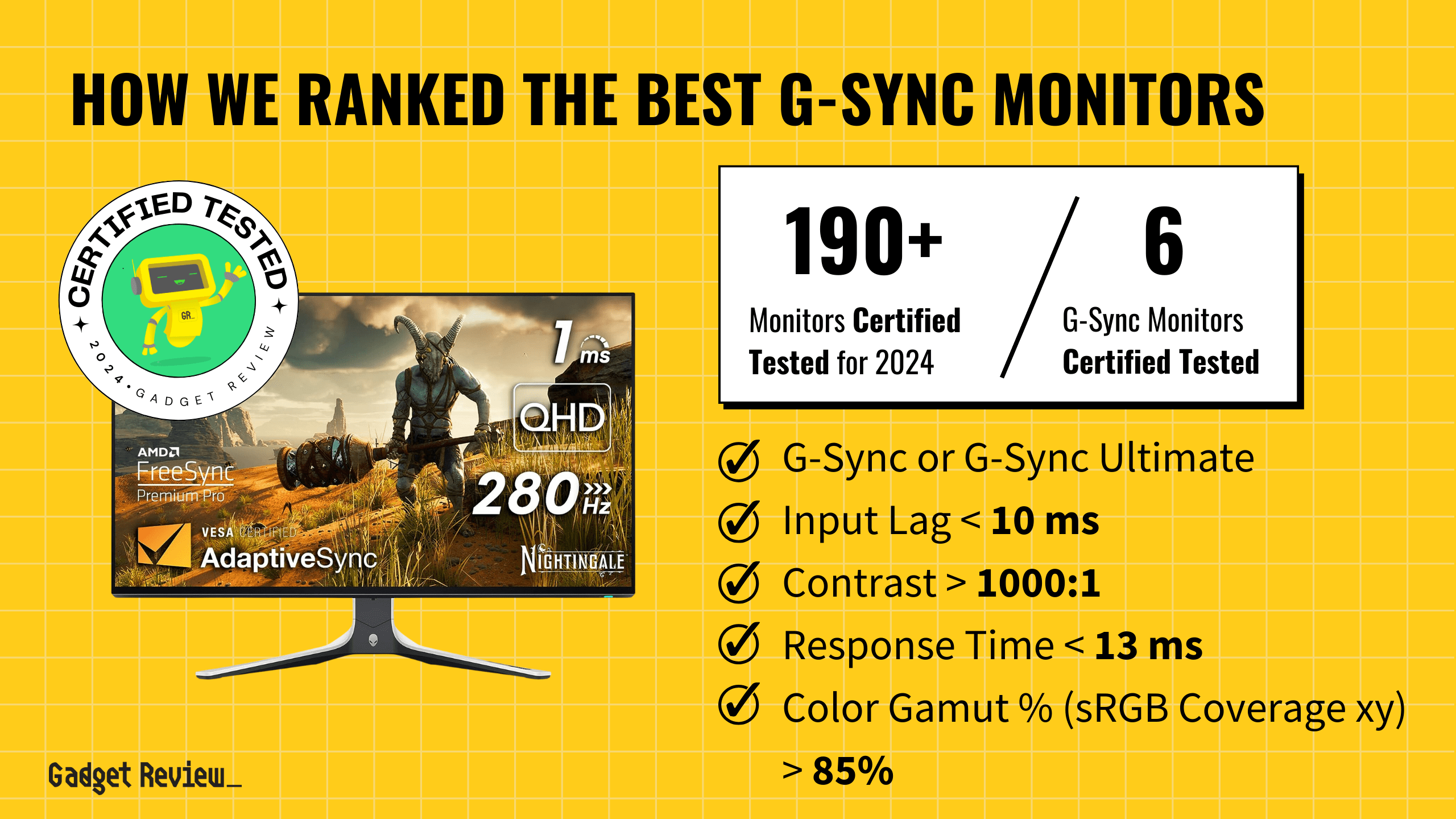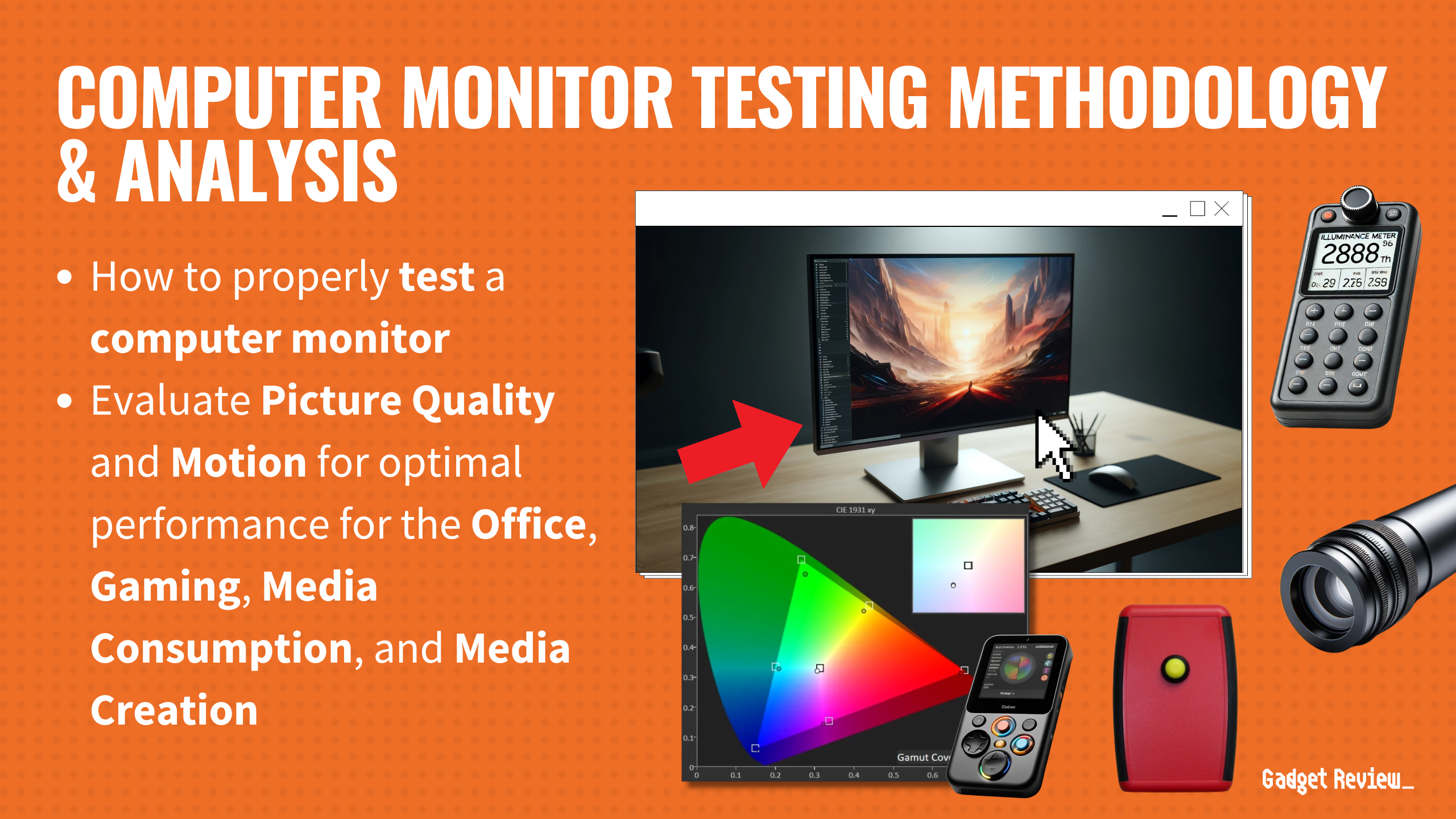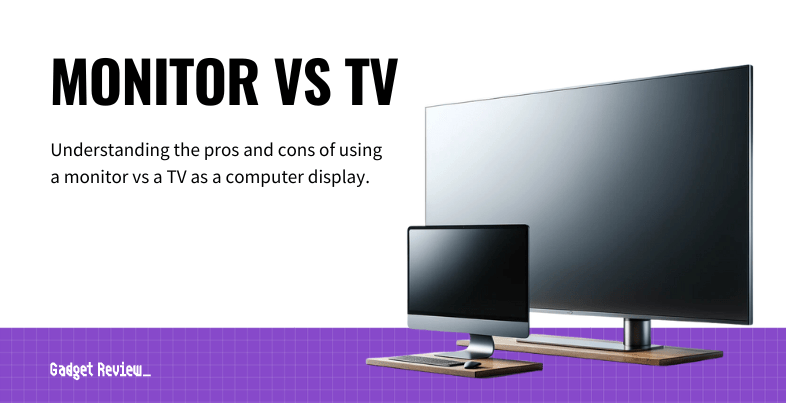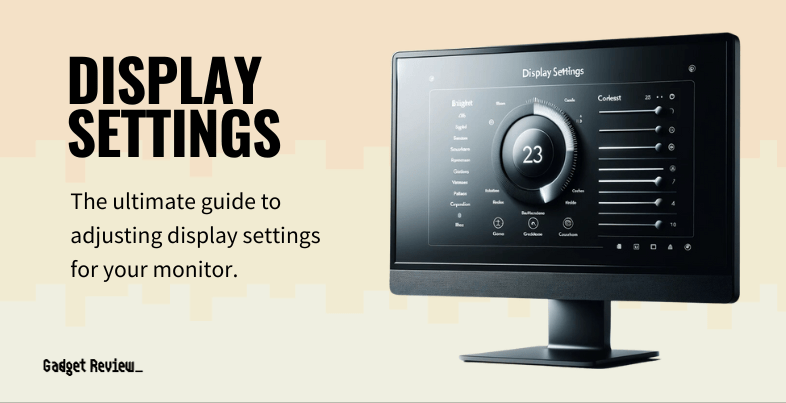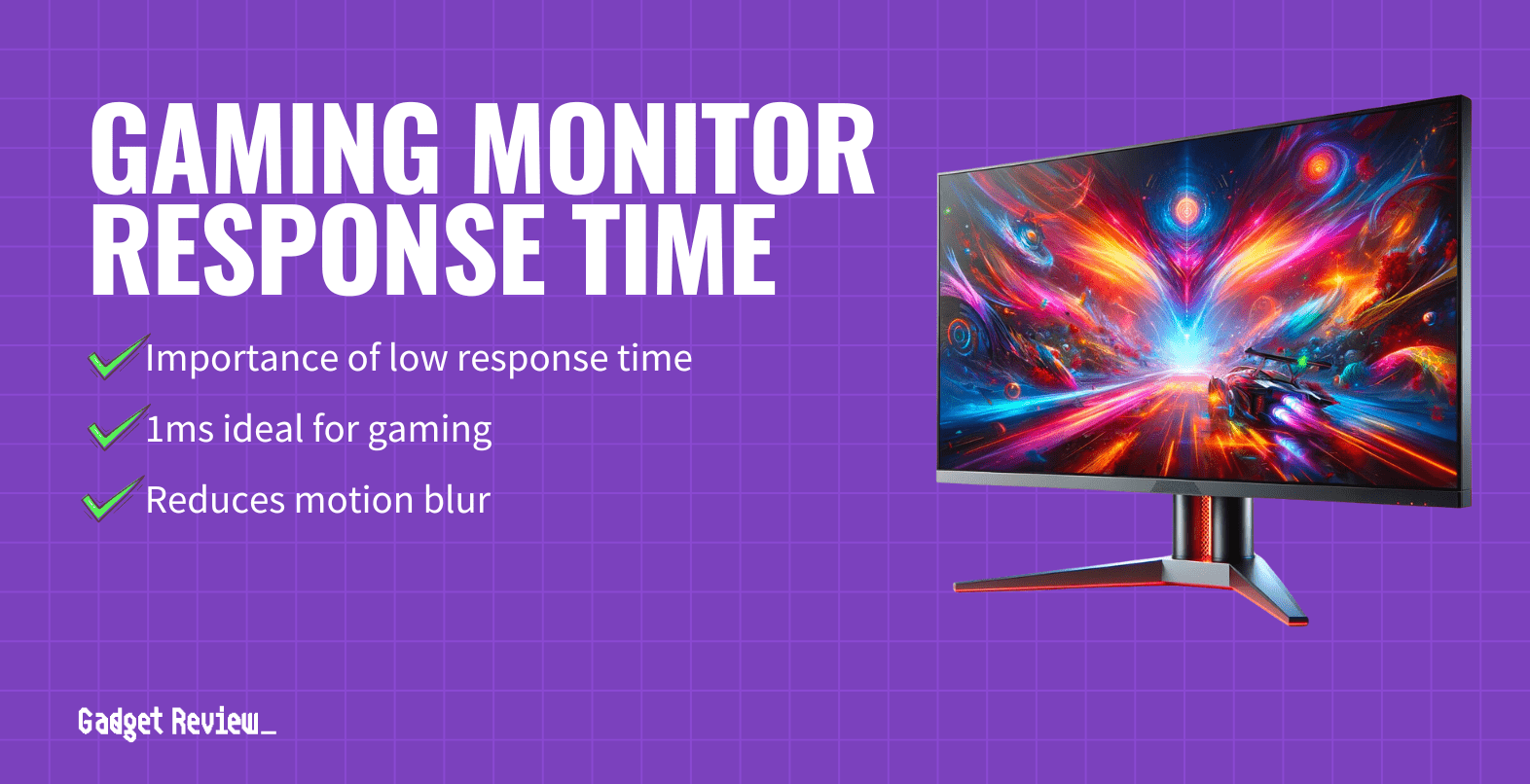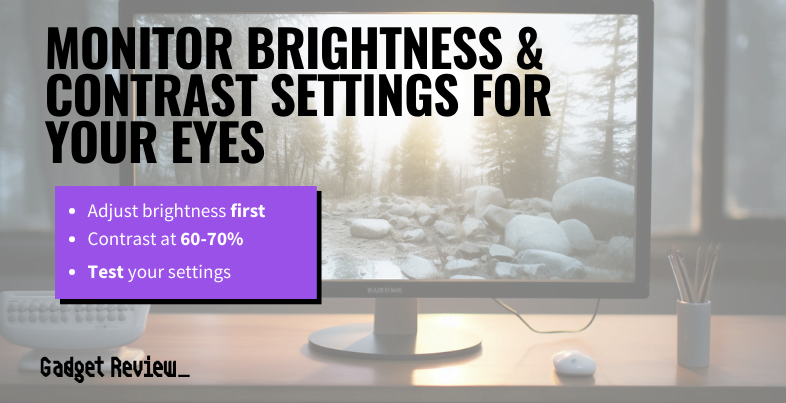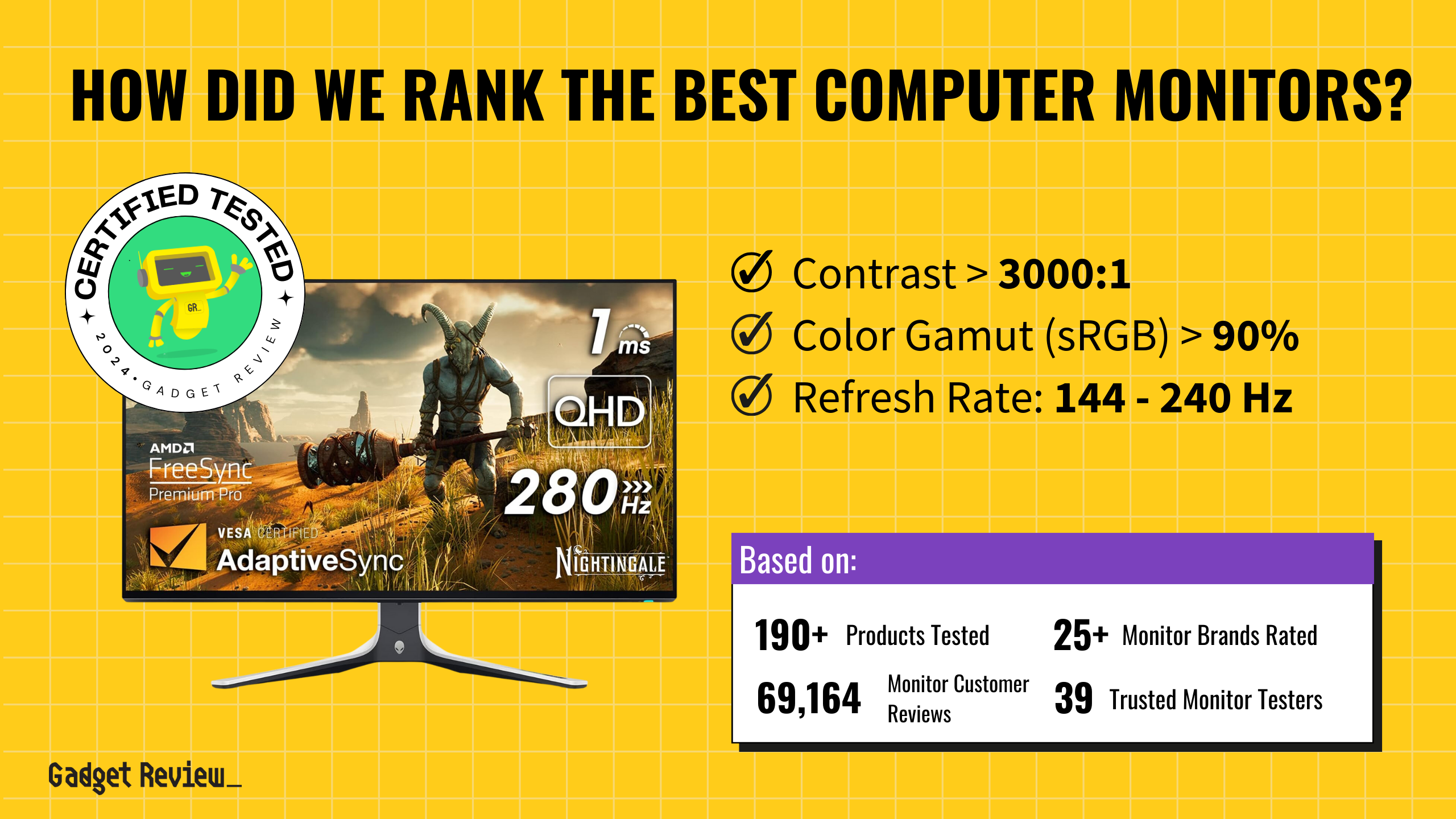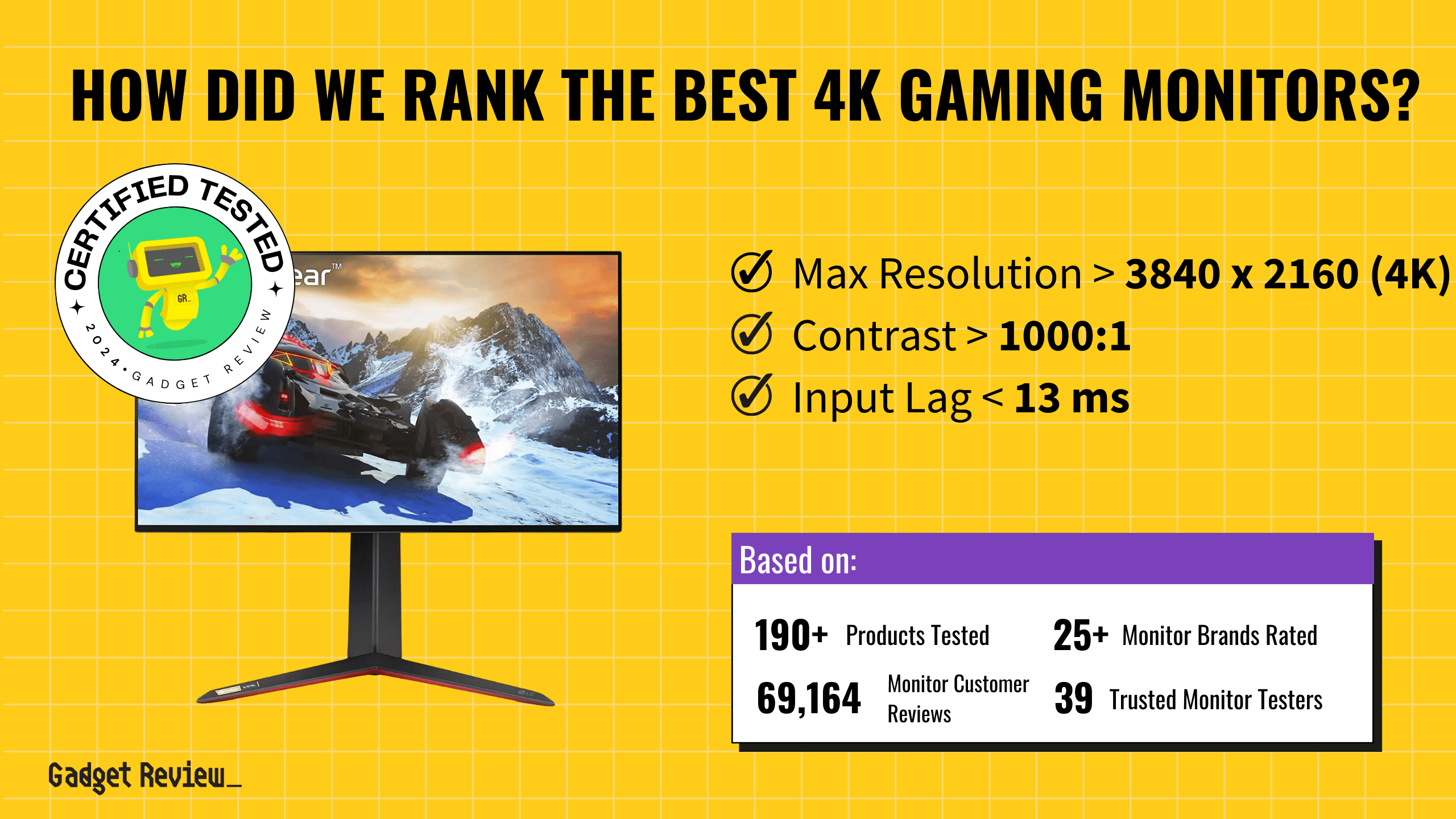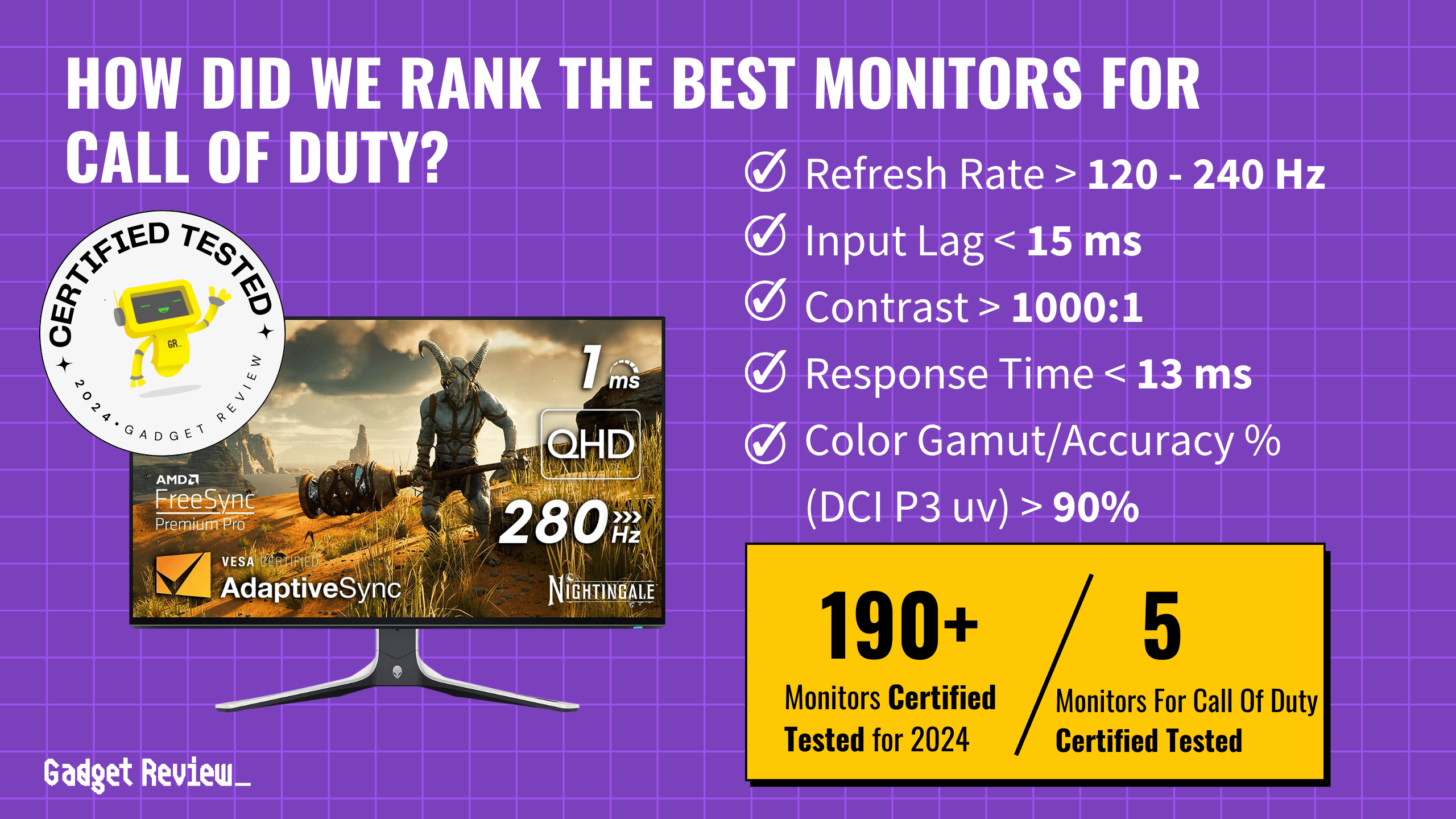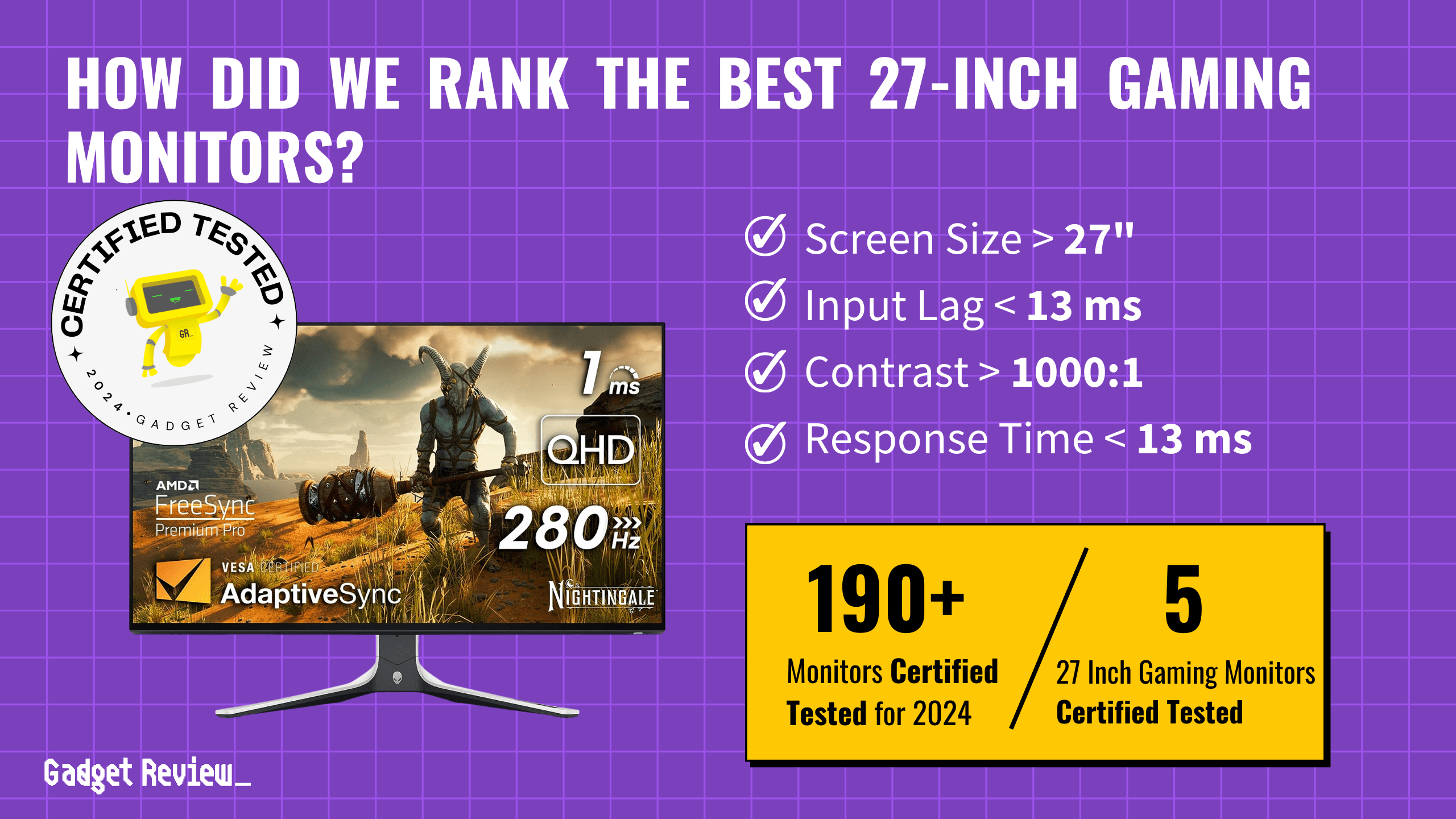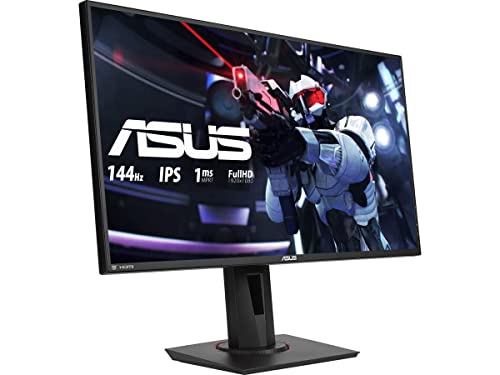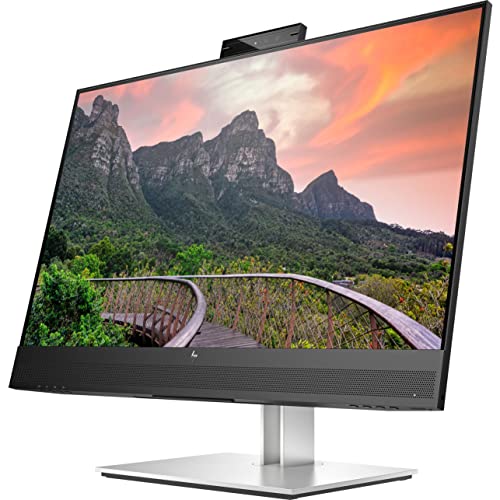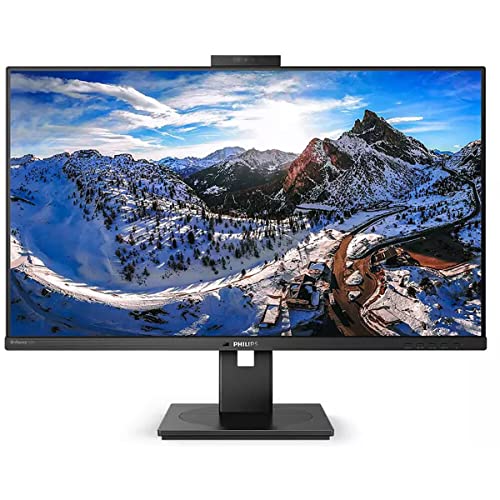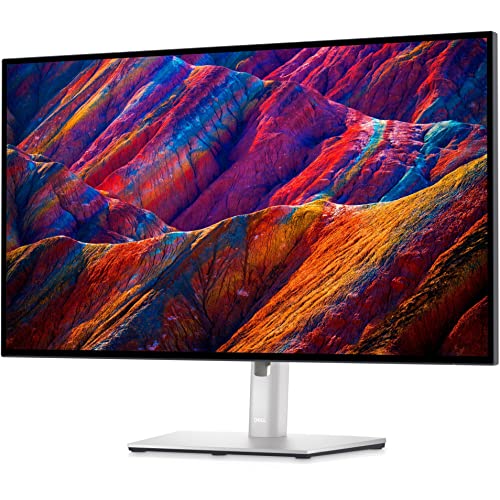When selecting the best G-Sync monitors, you need NVIDIA G-Sync technology to eliminate screen tearing and stuttering for smoother gameplay. The input lag should be under 10ms to guarantee rapid response times. A contrast ratio over 1000:1 ensures deep visual detail. High brightness and a wide color gamut provide vibrant, accurate colors, crucial for an immersive gaming experience. Low response time minimizes motion blur for clearer image transitions.
Out of 196 analyzed, only 6 monitors earned a place on our buying guide. We certified 30 monitors as tested, covering 320,301 reviews. Unfortunately, 71% of experts were untrustworthy. We filtered fake reviews and combined True Score with our proprietary Trust Score to identify the winning products. These performed well in testing, providing excellent G-Sync performance for gamers.
In addition to focusing on G-Sync technology, we also feature models that are the best gaming monitors with FreeSync technology, as well as the top computer monitors offering unparalleled performance across a range of uses.
How Did We Rank the Best G-Sync Monitors?
Our best G-Sync monitors buying guide is the result of a thorough analysis of over 200 websites, including testing methods and customer reviews. We prioritized the most critical pain points and essential criteria, focusing on 2 required test results, 2 nice-to-have test results, and 1 must-have specifications. This comprehensive approach ensures our guide is precise, reliable, and tailored to meet your gaming needs.
Our commitment to unbiased reviews is powered by our ‘True Score’ system, targeting low quality and fake reviews. When you shop through our links, you’re backing our mission. Dive deeper to see how.
Minimum Specifications
- Must have G-Sync technology.
Test Criteria
- Input Lag: An input lag of less than 10 milliseconds ensures a highly responsive gaming experience with minimal delay between action and on-screen response.
- Contrast Ratio: 1000:1 or higher, offering deep blacks and bright whites for an exceptional viewing experience.
“Nice To Haves”
- Fast Response Time: 13ms or less, ensuring smooth transitions without motion blur.
- Color Gamut: At least 85% of the sRGB Coverage xy, providing rich and vibrant colors.
Latest Updates
- 04/30/2024: Republished the list to include the best G-Sync monitors based on our True Score system.
Top G-Sync Monitors For 2025
Prices accurate at the time of publishing

Best Overall

Runner Up

Best Value

Best Budget

Best Mid-Range

Premium Pick
Asus ROG PG27AQDM
Best For Fortnite
The Asus ROG PG27AQDM is an excellent choice for gamers. It offers seamless gameplay with its high refresh rate, low reflections, and low response time, which ensure precision in competitive gaming.
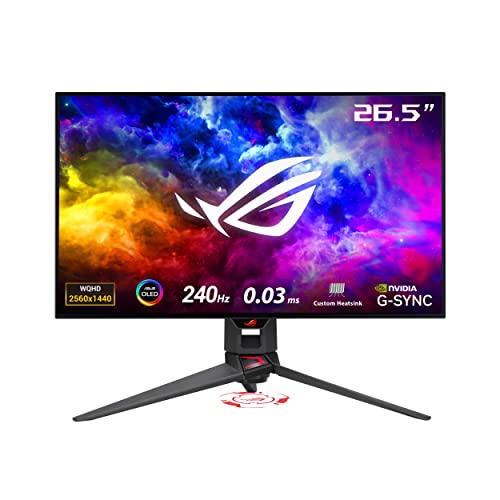
True Score
878910Experts
906kCustomers
Absolutely Fresh
 $733.02
$733.02Snapshot
Reasons to Buy
- Stellar Picture Quality
- Fast Response Time
- Low Input Lag
- High Refresh Rate and VRR Support
- Wide Viewing Angles
Reasons to Avoid
- No HDMI 2.1 Support
- Low Overall Brightness
Specifications

Aspect Ratio 16:9 
Available Inputs 3.5mm, DisplayPort, HDMI, USB 
Bluelight Filter Yes 
Built-In Speakers Yes 
Built-In Webcam No 
Curved Screen No Display Type LED 
Flicker Free Yes HDMI Inputs 2 HDR Format HDR10 High Dynamic Range (HDR) Yes Max Resolution 2560 x 1440 
Panel Type OLED Refresh Rate 240 Hz 
Response Time 0.03 ms 
Rotating Screen Yes Screen size 26.5" 
Sync Technology AMD FreeSync, G-Sync All Specs
Test Results
Brightness (nits) 311 Contrast Ratio (as ratio, x:1) 0 Color Gamut/Accuracy % (DCI P3 xy) 95 Color Gamut/Accuracy % (DCI P3 uv) 0 Color Gamut % (Adobe RGB Coverage xy) 90 Color Gamut % (sRGB Coverage xy) 100 All Retailers
- $733.02
Availability
In StockFree Shipping
Yes - $757.50
Availability
In StockFree Shipping
No
Our Verdict
The Asus ROG PG27AQDM strikes an amazing balance between performance and price, making it a fantastic choice for gamers who prioritize seamless gameplay. With its 240 Hz refresh rate and best-in-class 2.1 ms response time, this monitor is a powerhouse for competitive gaming and esports, ensuring that every frame is delivered precisely and without delay.
If you’re a gamer who can’t stand screen tearing, the dual compatibility with FreeSync and G-Sync ensures smooth, uninterrupted gameplay. This feature, combined with its low input lag of 10.8 ms, makes for a responsive gaming session in competitive environments. When compared to the LG 27GP950-B, they’re both priced as premium models, and the PG27AQDM has its leading response time for gaming, but the LG has deeper blacks and higher contrast versus the PG27AQDM’s 1042:1, which is still decent. The LG has a higher brightness level versus the PG27AQDM’s 311.2 nits, which holds up well in a bright indoor environment.
If visuals are your priority, the monitor’s 94.9% DCI-P3 color gamut coverage and HDR10 support mean your games and creative work, such as graphic design, will display accurate colors, enhancing the immersion. The OLED technology contributes to true blacks, adding depth to every scene. A best-in-class reflection rate of 2% means that glare is virtually non-existent, preserving visuals in brightly lit rooms.
The Asus ROG PG27AQDM, with its color accuracy, reflective rate, and rapid response time, is well-suited for gaming and creative work like graphic design and video editing, where color fidelity and detail are paramount. The compromise here is the premium price and higher input lag, but ultimately, this monitor is best suited for gamers and creatives looking for a high-performance display that excels in speed and visual quality.

Best Overall

Runner Up

Best Value

Best Budget

Best Mid-Range

Premium Pick
HP OMEN 27QS
Best For PS4
The HP OMEN 27QS offers an affordable, high-performance gaming experience with a 240 Hz refresh rate and 1440p resolution, ideal for competitive gamers and esports enthusiasts seeking precision and minimal motion blur.
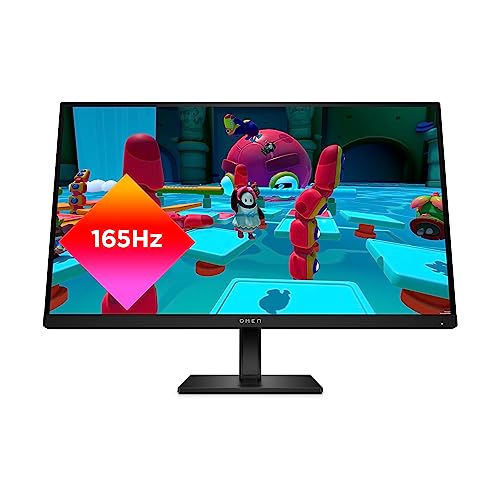
True Score
83824Experts
881kCustomers
Absolutely Fresh
 SAVE $69$229.00$159.99
SAVE $69$229.00$159.99Snapshot
Reasons to Buy
- Good Image quality
- Low response time
- Low input lag
- High refresh rate
Reasons to Avoid
- Low contrast ratio
Specifications

Aspect Ratio 16:9 
Available Inputs 3.5mm, DisplayPort, HDMI, USB 
Bluelight Filter Yes 
Built-In Speakers Yes 
Built-In Webcam No 
Curved Screen No Display Type LED 
Flicker Free Yes HDMI Inputs 2 HDR Format HDR10, HDR400 High Dynamic Range (HDR) Yes Max Resolution 2560 x 1440 
Panel Type IPS Refresh Rate 240 Hz 
Response Time 1 ms 
Rotating Screen Yes Screen size 27" 
Sync Technology AMD FreeSync Premium, G-Sync All Specs
Test Results
Brightness (nits) 390 Contrast Ratio (as ratio, x:1) 1,014 Color Gamut/Accuracy % (DCI P3 xy) 94 Color Gamut/Accuracy % (DCI P3 uv) 0 Color Gamut % (Adobe RGB Coverage xy) 86 Color Gamut % (sRGB Coverage xy) 100 All Retailers
- $159.99$229Save $69
Availability
In StockFree Shipping
No - $249.99$429Save $179
Availability
In StockFree Shipping
No - $479.99
Availability
Free Shipping
Yes
Our Verdict
The HP OMEN 27QS is a great choice for budget-conscious gamers looking to balance high performance and affordability, offering a robust 240 Hz refresh rate and a crisp 1440p resolution. It’s well-suited for competitive gamers and esports enthusiasts who need precision and speed, thanks to its 4.2 ms response time and 8.5 ms input lag to ensure minimal motion blur and swiftness. Compared to the Asus ROG PG27AQDM, the HP is better for brighter rooms, but if you’re a competitive gamer, the Asus is much faster and more responsive. The G-Sync and FreeSync support further enhance gaming by eliminating screen tearing and providing smooth gameplay.
If you need vibrant colors and sharp details for games and color-critical work like design, the OMEN 27QS’s impressive 94.4% DCI-P3 color gamut and HDR400 certification will ensure your games run smoothly and look great. With a great brightness of 389.5 nits and a contrast ratio of 1014:1, visuals are clear and engaging in bright lighting conditions. The monitor’s reflection rate of 4.8% also ensures that glare is kept to a minimum, preserving image quality from different viewing angles.
The HP OMEN 27QS, with its excellent blend of speed and image quality at an affordable price, proves to be a versatile choice for gaming, streaming, content creation, and graphic design. Despite the compromise that it doesn’t beat the other models in any particular area, it’s still a well-rounded monitor, making it a top pick for users looking for a high-quality, multifunctional display.

Best Overall

Runner Up

Best Value

Best Budget

Best Mid-Range

Premium Pick
LG 27GP950-B
Best For 4K
The LG 27GP950-B excels for both gaming and creative work, blending 4K clarity with a 144 Hz refresh rate, outstanding color accuracy, great input lag, and HDR600 for vivid visuals.
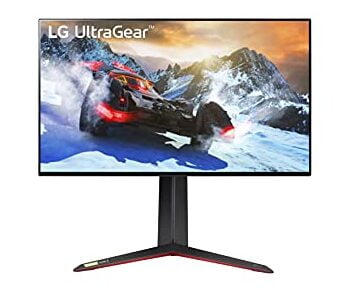
True Score
82834Experts
87903Customers
Absolutely Fresh
 SAVE $423$899.99$476.99
SAVE $423$899.99$476.99Snapshot
Reasons to Buy
- 4K resolution delivers great picture quality
- High peak brightness level
- Great color accuracy
- HDMI 2.1 ports for connectivity to modern consoles
- Support for HDR content
Reasons to Avoid
- Low contrast
- Poor reflection handling
- So-so ergonomics
Specifications

Available Inputs 3.5mm, DisplayPort, HDMI, USB 
Bluelight Filter n/a 
Built-In Speakers No 
Built-In Webcam No 
Curved Screen No Display Type IPS 
Flicker Free Yes HDMI Inputs 2 HDR Format HDR10, HDR600 High Dynamic Range (HDR) Yes Max Resolution 3840 x 2160 (4k) 
Panel Type IPS Refresh Rate 144 Hz 
Response Time 1 ms 
Rotating Screen Yes Screen size 27" 
Sync Technology AMD FreeSync, AMD FreeSync Premium Pro, G-Sync All Specs
Test Results
Brightness (nits) 410 Contrast Ratio (as ratio x:1) 1,194 Color Gamut/Accuracy % (DCI P3 xy) 97 Color Gamut/Accuracy % (DCI P3 uv) 0 Color Gamut % (sRGB Coverage xy) 100 Color Gamut % (Adobe RGB Coverage xy) 88 All Retailers
- $476.99$900Save $423
Availability
In StockFree Shipping
Yes - $496.99$897Save $400
Availability
In StockFree Shipping
- $896.99$937Save $40
Availability
In StockFree Shipping
No - $899.99
Availability
In StockFree Shipping
Yes
Our Verdict
The LG 27GP950-B is an excellent option for gamers and creative professionals working in bright rooms that need superb color accuracy, delivering high performance with a 4K resolution at a 144 Hz refresh rate. The refresh rate is lower than other monitors on our list, but this is still excellent for competitive gaming. If vibrant colors and deep contrasts are crucial to you, this monitor’s best-in-class 96.8% DCI P3 color gamut and HDR600 support offers outstanding visual quality. With a brightness of 410 nits and a contrast ratio of 1194:1, it ensures that visuals are not only bright but also rich in detail and color accuracy, setting a high standard for graphic design, video editing, and content creation.
If you’re an esports athlete or competitive gamer, the LG’s 4.4 ms response time and best-in-class 4.2 ms input lag ensure a smooth, responsive gaming experience. This monitor distinguishes itself from the Dell G2724D by offering superior 4K resolution, making it better suited for users who prioritize visual fidelity in gaming and professional creative work. However, the Dell is brighter and better for dealing with direct sunlight. The LG’s compatibility with FreeSync and G-Sync minimizes screen tearing, providing seamless gameplay across diverse hardware.
The LG 27GP950-B, with its blend of high-resolution performance, small input lag, and color fidelity, proves ideal for a broad range of applications beyond gaming, including streaming, professional editing, and simulation environments. The compromise is mainly its steep price, but its performance makes it a justified investment for competitive gamers, creatives, and general users looking for a multifaceted monitor that delivers a premium viewing and gaming experience.
Did you know 71% of computer monitor reviewers are untrustworthy?
Our research found only 33 of 110+ computer monitor reviewers as of December 2025 can be trusted. This is why Gadget Review is committed to calculating the most accurate product scores on the web.
To do this, we give every computer monitor review site a Trust Rating, which measures how trustworthy the site and their testing claims are. We then leverage AI & a machine learning model to combine and calculate the Trust Rating with data from experts and consumers to deliver the True Score, the web’s most accurate product quality rating.
 320,301
320,301Monitor Reviews Analyzed

196
Total Products Analyzed

Best Overall

Runner Up

Best Value

Best Budget

Best Mid-Range

Premium Pick
Dell G2724D
The Dell G2724D is great for budget-conscious gamers needing high performance and quick response time. It delivers immersive gaming, offering smooth, tear-free play with its adaptive sync capabilities, set in a bright, contrast-rich display.
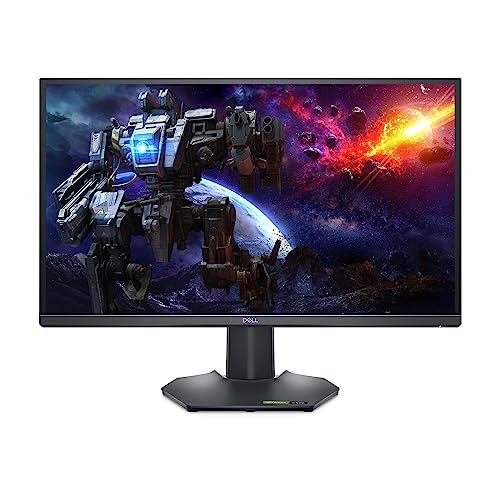
True Score
82822Experts
88126Customers
Absolutely Fresh

Snapshot
Reasons to Buy
- Great image quality
- Low Input lag
- High native refresh rate
Reasons to Avoid
- Subpar contrast ratio and HDR color gamut
- Okay response time
- No HDMI 2.1 and USB ports
Specifications

Aspect Ratio 16:9 
Available Inputs DisplayPort, HDMI 
Bluelight Filter Yes 
Built-In Speakers No 
Built-In Webcam No 
Curved Screen No Display Type LED 
Flicker Free Yes HDMI Inputs 2 HDR Format HDR10, HDR400 High Dynamic Range (HDR) Yes Max Resolution 2560 x 1440 
Panel Type IPS Refresh Rate 165 Hz 
Response Time 1 ms 
Rotating Screen Yes Screen size 27" 
Sync Technology AMD FreeSync Premium, G-Sync, VESA Adaptive-Sync All Specs
Test Results
Brightness (nits) 432 Contrast Ratio (as ratio, x:1) 1,350 Color Gamut/Accuracy % (DCI P3 xy) 86 Color Gamut/Accuracy % (DCI P3 uv) 0 Color Gamut % (Adobe RGB Coverage xy) 82 Color Gamut % (sRGB Coverage xy) 100 All Retailers
Availability
Free Shipping
Our Verdict
The Dell G2724D is an exceptional choice for budget gamers seeking a blend of affordability and high performance in bright environments. Offering a 165 Hz refresh rate and a 4.3 ms response time at a 1440p resolution, it’s poised for competitive and casual gaming. While the LG 27GP950-B pushes ahead with a 4K display, the Dell G2724D offers a competitive edge with its higher brightness and contrast ratio, while the LG is better at color accuracy.
The Dell’s 9 ms input lag also translates to a highly responsive gaming experience if you’re deep into competitive gaming. Its G-Sync and FreeSync support ensure smooth, tear-free gameplay, which is crucial for maintaining the upper hand in fast-paced matches. For those prioritizing vibrant displays and sharp visuals, the G2724D’s 86.4% DCI P3 color gamut and HDR400 certification might not match the top-tier monitors but still deliver pleasing color fidelity and contrast. Its best-in-class 432 nits brightness and unmatched 1350:1 contrast ratio ensure that games have accurate colors and deep black levels under bright lighting conditions. A reflective rate of 4.8% also supports it to minimize distracting glare.
If you plan to use it in a bright room and don’t mind having the most color-accurate model, you’ll appreciate this well-rounded mix of responsiveness, bright visual quality, and adaptive sync features. Despite the trade-off in color coverage, its high contrast and brightness make it versatile for gaming and everyday use. This monitor is a compelling option for those seeking a reliable, performance-oriented display without venturing into the premium price range.

DON’T SEE WHAT YOU’RE LOOKING FOR?
If you’re a console gamer, choosing the best gaming monitor for PS4 or the top choice for PS5 can significantly enhance your gaming experience. These monitors should ideally support resolutions that match the console’s capabilities to maximize the visual output. For those curious about resolutions, what is a 4K monitor? Simply put, it offers four times the resolution of a standard 1080p HD screen, providing sharper and more detailed images.
When comparing 4K vs 2K computer monitors, the higher resolution of a 4K monitor offers clearer and more detailed visuals, which is especially noticeable in gaming and high-definition content. However, you may need to learn how to fix input lag monitor issues more frequently with higher resolution monitors, as they require more processing power from your gaming setup to maintain smooth gameplay.

Best Overall

Runner Up

Best Value

Best Budget

Best Mid-Range

Premium Pick
Alienware AW2723DF
Best For Nintendo Switch
The Alienware AW2723DF is ideal for gamers and creatives, offering fluid gameplay, vivid colors, and great brightness. Its performance is well-rounded for both play and work despite minor compromises in contrast and glare.
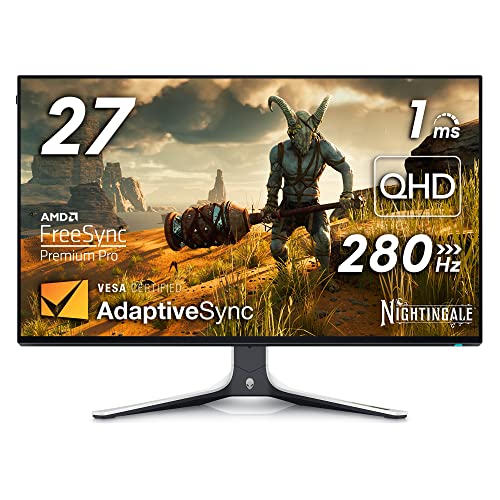
True Score
78804Experts
81293Customers
Mixed Reviews
 SAVE $200$549.99$349.99
SAVE $200$549.99$349.99Snapshot
Reasons to Buy
- Superb image quality
- Low input lag
- High native refresh rate
Reasons to Avoid
- Mediocre contrast ratio
- Adequate response time
- No HDMI 2.1
Specifications

Available Inputs 3.5mm, DisplayPort, HDMI, USB 
Bluelight Filter Yes 
Built-In Speakers No 
Built-In Webcam No 
Curved Screen No Display Type IPS 
Flicker Free Yes HDMI Inputs 2 HDR Format HDR10, HDR600 High Dynamic Range (HDR) Yes Max Resolution 2560 x 1440 
Panel Type IPS Refresh Rate 240 Hz 
Response Time 1 ms 
Rotating Screen Yes Screen size 27" 
Sync Technology AMD FreeSync Premium Pro, G-Sync All Specs
Test Results
Brightness (nits) 403 Contrast Ratio (as ratio, x:1) 1,015 Color Gamut/Accuracy % (DCI P3 xy) 93 Color Gamut/Accuracy % (DCI P3 uv) 0 Color Gamut % (Adobe RGB Coverage xy) 90 Color Gamut % (sRGB Coverage xy) 100 All Retailers
- $349.99$550Save $200
Availability
In StockFree Shipping
Yes - $433.49$705Save $271
Availability
In StockFree Shipping
No
Our Verdict
The Alienware AW2723DF marks an outstanding sweet spot if you’re a gamer prioritizing fluid gameplay and stellar image quality without breaking the bank. Its 1440p resolution at a 240 Hz refresh rate and a 4.6 ms response time make it ideal for competitive gaming and esports, offering a clear, responsive experience. It has a similar input lag to the HP OMEN 27QS at 8.6 ms, ensuring minimal delay between your actions and what’s displayed, though the AW2723DF has a higher brightness. It’s suited for fast-paced gamers, streamers, and content creators who value precision and speed. If you’re into competitive gaming, its FreeSync and G-Sync compatibility mean tear-free gameplay across various GPUs.
If you’re a content creator or appreciate high-quality visuals, its 93% DCI-P3 color coverage and HDR600 support offer vibrant colors and deeper contrasts that are good for graphic designers and video editors. With a fantastic brightness of 402.8 nits, your games look great even in well-lit rooms. However, the contrast ratio of 1015:1, while still decent so you get bright whites and deep black levels, the measurement doesn’t lead the pack, meaning it’s a slight compromise for those seeking the deepest blacks. The reflection percentage of 7.6% ensures that screen glare is significantly minimized, though it’s not the lowest on this list.
Its brightness and color coverage make it well-suited for more than just gaming like graphic design, video editing, and even as a developer’s workstation. The compromise is the adequate reflective rate and contrast ratio, which may not satisfy the most demanding visual enthusiasts. Ultimately, this mid-range monitor suits serious gamers and creative professionals, offering robust features that enhance play and work.
Category Snapshot
Computer Monitors
- Total Brands/Products Tested
27 Brands, 196 Products
- Top 2 Brands
Dell, HP
- Price Range (Budget-Premium)
$100-$1,500
- Average True Score
74.46
- Important Test Criteria
Brightness (cd/m2)
Contrast Ratio (1000:1) - Most Trusted Testers

- Top Monitor Experts
- Typical Warranty
2 years
- Covered by Insurance
Yes – AKKO

Best Overall

Runner Up

Best Value

Best Budget

Best Mid-Range

Premium Pick
Samsung Odyssey G7 S28AG70
Best For 4K Gaming
The Samsung Odyssey G7 S28Ag70 delivers a 4K gaming experience with a swift response time, making it suited for gamers and professionals seeking visuals with good contrast and smooth gameplay.
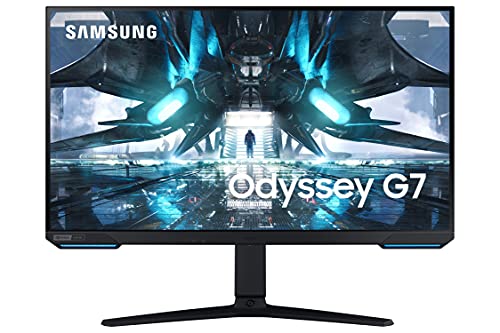
True Score
72711Experts
781kCustomers
Mixed Reviews
 SAVE $263$799.99$537.00
SAVE $263$799.99$537.00Snapshot
Reasons to Buy
Reasons to Avoid
Specifications

Available Inputs 3.5mm, DisplayPort, HDMI, USB 
Bluelight Filter Yes 
Built-In Speakers No 
Built-In Webcam No 
Curved Screen No Display Type IPS 
Flicker Free Yes HDMI Inputs 2 HDR Format HDR10, HDR400 High Dynamic Range (HDR) Yes Max Resolution 3840 x 2160 (4k) 
Panel Type IPS Refresh Rate 144 Hz 
Response Time 1 ms 
Rotating Screen Yes Screen size 28" 
Sync Technology AMD FreeSync Premium Pro, G-Sync All Specs
Test Results
Brightness (nits) 285 Contrast Ratio (as ratio, x:1) 1,155 Color Gamut/Accuracy % (DCI P3 xy) 87 Color Gamut/Accuracy % (DCI P3 uv) 0 Color Gamut % (Adobe RGB Coverage xy) 83 Color Gamut % (sRGB Coverage xy) 99 All Retailers
- $537.00$800Save $263
Availability
In StockFree Shipping
Yes
Our Verdict
The Samsung Odyssey G7 S28Ag70 offers gamers a high-quality 4K experience with a 144 Hz refresh rate and a swift 2.8 ms response time, ideal for those seeking good contrast without sacrificing speed. Tailored for gamers and content creators who demand high resolution, it distinguishes itself from the Dell G2724D by delivering superior 4K resolution, making it a better choice for users who prioritize visual quality over the highest brightness. Both are fairly even when it comes to color accuracy.
If you’re a gaming enthusiast, the Odyssey G7’s combination of G-Sync and FreeSync Premium Pro compatibility ensures smooth, tear-free gaming across a wide range of hardware setups. Despite its slightly higher input lag of 12.8 ms, it still offers a responsive gaming experience, thanks to its high refresh rate and rapid response time.
With its HDR400 support and 86.7% DCI P3 color coverage, it provides accurate enough color representation for gaming or productivity tasks, but creative professionals who rely heavily on color accuracy may want to look elsewhere. Its 285 nits of brightness could be better, but its great 1155:1 contrast ratio provides vibrant enough images with bright whites and deep black levels. It also has a good reflective rate of 5.3% to adequately tackle glare from bright lights.
This monitor is a compelling choice if you’re looking for a 4K gaming monitor that doesn’t compromise gaming performance. While it may have a higher input lag and price tag, its contrast levels, response time, and adaptive sync capabilities make it versatile for gaming, streaming, and productivity work.
Which Criteria Matters for Testing Best G-Sync Monitors?
By focusing on these criteria (2 required, 2 nice to have), anyone can quickly and easily compare these computer monitors and how they’ll perform. This helps you make an informed decision and purchase the best G-Sync monitor!
| CRITERIA | RANGE | REQUIRED | DEFINITION |
|---|---|---|---|
| Input Lag | < 10 ms | Yes | The time it takes for the monitor to register inputs from the user and process them as action. |
| Contrast Ratio | >1000:1 | Yes | The difference in brightness between the whites (lit sections) and blacks (dim or unlit sections) of a monitor panel. |
| Color Gamut % (sRGB Coverage xy) | > 85% | No (Nice to have) | How much of the sRGB color gamut is covered by the monitor, which helps indicate color accuracy for web content and games. |
| Response Time | < 13 ms | No (Nice to have) | The time it takes for a pixel to change from one color to another. |
Our Trusted Data Sources
We looked at 110+ computer monitor reviewers and found that 33 are trustworthy (60%+ Trust Rating). The three we have listed below are our most trusted for computer monitors.
- Samuel Breton – Rtings, MuckRack
- Chris Eberle – Tom’s Hardware, LinkedIn
- Tony Hoffman – PC Mag, MuckRack
Interested in a comprehensive analysis of our data sources? We’ve got you covered. Below, you’ll find a detailed list of every computer monitor review website we’ve identified, organized by their respective Trust Ratings from highest to lowest. But we didn’t stop there. We’ve meticulously reviewed each publication and verified the data by checking whether the authors have bio links to MuckRack or LinkedIn. We’re committed to not only checking the facts but ensuring their veracity.
Computer Monitor Test Data & Results
1. Input Lag (ms) Test Results
Input Lag (ms)
< 10 ms
Acceptable range of performance
Definition: The amount of time it takes for a monitor to register an input from the user and display it.
Units of Measurement: Milliseconds (ms)
Tools to Measure: Input Lag Meter
Why It’s Important:
Input lag introduces artificial delay when gaming, which creates a mismatch between your reactions and on-screen action and creates frustration.
Input lag is more of a concern when it comes to gaming, but if you plan on using a monitor for a bit of gaming when you aren’t focused on productivity, editing or other tasks, lower values help improve responsiveness. High input lag means your actions take longer to register on the monitor, effectively introducing an artificial delay to your reactions.
It’s for this reason that we generally recommend an input lag under 10 ms. This ensures the delay that’s introduced has minimal impact on your reactions to what’s happening on screen. It’s important to note that a high input lag won’t have any real effect on anything that isn’t gaming, so it can be safely ignored if you don’t plan on gaming on your monitor.
Input Lag (in ms; lower is better)
2. Contrast Ratio (as ratio, x:1) Test Results
Contrast Ratio
> 1000:1
Acceptable range of performance
Definition: How bright the monitor will get, usually under specific testing conditions, like 10% windows (which means 10% of the screen is a white box.)
Units of Measurement: Ratio
Tools to Measure: Luminance meter or photometer or colorimeter
Why It’s Important:
Contrast ratio is how dynamic images are given detail and dramatic effect, with very dark areas appearing truly dark, while bright areas are bright and pop.
Contrast ratio is responsible for making images appear “dynamic” and “dramatic.” By having a good contrast ratio, a monitor is able to recreate dramatic differences between light and dark spots in scenes, images and games accurately.
At a minimum, we recommend a contrast ratio of 1000:1, as this will do a good enough job at allow for detail in dark scenes and images. If contrast ratio gets too low, the picture quality suffers, and the monitor performs worse across the board, no matter the lighting condition. By getting a monitor with a sufficiently high contrast ratio, you can ensure the picture quality doesn’t suffer, and dramatic scenes with stark shifts in lighting, whether they be in games or videos, are created as accurately as possible.
Contrast Ratio (higher is better)
3. Color Gamut % (Adobe RGB Coverage xy) Test Results
As the name might imply, the Adobe RGB gamut is mostly focused on photo printing, and was developed by Adobe themselves in order to give users the ability to know how a photo would look if it was printed using standard CMYK printers.
If you’re printing a lot of photos and editing them in most photo programs, this is a commonly used color gamut. By having it be at least 85% covered and properly calibrated, your monitor is able to show you how a photo you’re editing will look when it’s printed out. If the coverage of this gamut isn’t high enough, you’ll suffer the opposite, and may end up wasting a lot of ink on photos that look great on your screen but seem to come out completely off when you print them.
Color Gamut % (Adobe RGB Coverage xy)
> 85%
Acceptable range of performance
Definition: The amount of the Adobe RGB color space that the monitor covers with its panel.
Units of Measurement: %
Tools to Measure: Colorimeter
Why It’s Important:
The Adobe RGB color gamut is important for helping to ensure that photos are printed true to the editor’s intentions.
Color Gamut Adobe RGB (in %; higher is better)
4. Response Time (ms) Test Results
Response time measures how long it takes pixels to change from one color to another, often gray to gray. Low response times means the monitor is able to keep up with constant shifts in colors, and helps prevent motion blur from being introduced whatever you’re watching.
We generally recommend a response time that is 13 ms or less, as this will keep motion blur to a minimum, but if you don’t watch a lot of very high intensity videos or play fast-paced games, response time isn’t going to matter much. It’s important to note that monitors will often advertise a 1ms or 2ms or 5ms response time, to name a few, but response time tests measure full color to color shifts, as well as overshoots, which produces different times than what the monitor often claims on the box. This is why response time is a listed spec, but also a testable criterion.
Response Time (ms)
< 13 ms
Acceptable range of performance
Definition: The amount of time it takes for pixels on a monitor to shift from one color to another.
Units of Measurement: Milliseconds (ms)
Tools to Measure: Response time tool, camera
Why It’s Important:
Faster response times keep the screen from becoming muddied and blurred when fast-paced action scenes in movies or games start.
Response Time (in ms; lower is better)
Best G-Sync Monitors: Mistakes To Avoid
- Neglecting Panel Type: Not evaluating panel types such as IPS, TN, or VA can lead to choosing a monitor with inferior color reproduction or viewing angles, impacting the overall visual quality and gaming experience. Additionally, understanding the importance of monitor viewing angle is essential, as it determines how the image quality maintains consistency when viewed from different positions, thus affecting both your comfort and immersion.
- Underestimating Response Time: Ignoring response time can result in motion blur and ghosting artifacts, affecting visual clarity during fast-paced gaming, particularly in competitive multiplayer games. When comparing 2ms vs 1ms response times, the difference might seem minor, but that millisecond improvement can significantly enhance the sharpness of moving images, giving competitive gamers a crucial edge in reaction speed.
- Dismissing HDR Support: Failing to consider HDR support can result in missing out on enhanced visual fidelity and dynamic range, as HDR technology provides deeper blacks, brighter highlights, and more vibrant colors for a more immersive gaming experience. Many of the top 4K monitors come equipped with HDR, further elevating the level of detail and color accuracy, making them ideal for both gaming and professional creative work.
- Neglecting Connectivity Options: Failing to consider connectivity options such as HDMI and DisplayPort can limit your monitor’s compatibility with gaming consoles, PCs, and other devices, potentially restricting your gaming setup’s versatility. Understanding different monitor cable types, including HDMI, DisplayPort, DVI, and VGA, is crucial for ensuring optimal data transmission and picture quality, depending on your gaming or professional needs.
The Best G-Sync Monitors Tests Compared
Product |
True Score
|
Brightness
|
Contrast Ratio
|
Color Gamut (DCI P3)
|
Color Gamut (sRGB)
|
Input Lag (ms)
|
Response Time (ms)
|
Reflections % | |
|---|---|---|---|---|---|---|---|---|---|
| 87 |
|
|
|
|
|
|
| $733.02 |
| 83 |
|
|
|
|
|
|
| $159.99 $229 $69 |
| 82 |
|
|
|
|
|
|
| $476.99 $900 $423 |
| 82 |
|
|
|
|
|
|
| |
| 78 |
|
|
|
|
|
|
| $349.99 $550 $200 |
| 72 |
|
|
|
|
|
|
| $537.00 $800 $263 |


